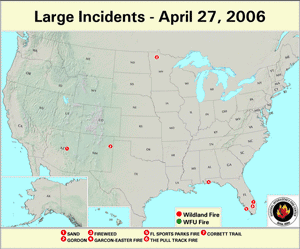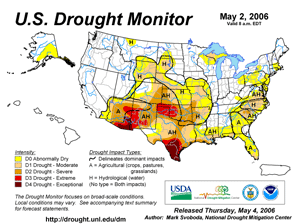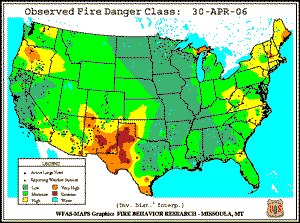Wildland fire activity was above normal during April, which continued the anomalous activity since the beginning of 2006. Fires continued to affect parts of the southwest and southern U.S. during April, while wildfire activity developed in Florida in April and early May. The dramatic increase in fire activity in Florida over the past few weeks has subsequently spread statewide, threatening many homes and structures, and also impacting parts of the state with smoke and reduced visibilties.
There have been over 37,000 wildland fires across the Lower 48 States since the beginning of 2006, with large fire activity focused in the central and southern Plains, the Southwest and the Florida peninsula. As of May 5th, over 2.3 million acres have burned across the U.S., according to estimates from the National Interagency Fire Center.
Of the total acreage, approximately 1.8 million acres have burned in the Southern Area (which encompasses 13 states, Puerto Rico, the Virgin Islands and the District of Columbia). Spring is typically a period when wildland fire activity begins to increase across the contiguous U.S., but both the number of fires and the acreage burned have been well above normal so far this year.
| Totals as of early May | Nationwide Number of Fires | Nationwide Number of Acres Burned |
|---|---|---|
| 5/3/2006 | 36,087 | 2,291,025 |
| 5/3/2005 | 18,735 | 273,884 |
| 5/3/2004 | 24,856 | 377,000 |
| 5/3/2003 | 16,742 | 336,367 |
| 5/3/2002 | 24,421 | 442,575 |
| 5/3/2001 | 24,284 | 481,518 |
| 5/3/2000 | 29,606 | 750,256 |
Dead fuel moisture levels remained very dry in April. The 10–hour fuel moisture levels on April 30th were extremely dry, with the observed levels below 5% across parts of the High Plains and Southwest states.
Medium to larger fuels (i.e., the April 30th 100–hr and April 30th 1000–hr fuel moistures) also remained unusually dry over the past month, especially across New Mexico, southern and western Texas, southeast Colorado, and western Oklahoma and Kansas.
The Keetch–Byram Drought Index (KBDI), a widely used index for fire risk, had the largest potential for wildland fire activity in the contiguous U.S. across parts of the Southwest, southern Texas, and Florida at the end of April. In addition, the observed experimental fire potential index in early May was also anomalously high for a large area of the Southwest.
For further information on drought conditions across the U.S. go to the April drought summary page.
 NOAA's National Centers for Environmental Information
NOAA's National Centers for Environmental Information


